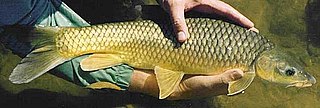
The Olifants River is a river in the northwestern area of the Western Cape Province of South Africa. The upper and main catchment area of the Olifants river is around Ceres and the Cederberg mountains. The Clanwilliam and Bulshoek dams are located on the river and provide water for the towns and farms along the watercourse. The river is approximately 285 km long with a catchment area of 46,220 km2 and flows into the Atlantic Ocean at Papendorp, 250 km north of Cape Town.

The Clanwilliam yellowfish is a ray-finned fish species in the family Cyprinidae. It has long been placed in Barbus, the "wastebin genus" for barbs, by default; however, the species is increasingly being restored to related yellowfish genus Labeobarbus which seems a much more appropriate placement. It is hexaploid like the other yellowfish, among which it is more closely related to the smallscale yellowfish than to the largescale yellowfish.
The Twee River redfin or simply Twee redfin is a ray-finned fish species in the family Cyprinidae. It is placed with the South African redfins in Pseudobarbus. It is tetraploid. Its closest living relative is probably the Clanwilliam redfin.

Labeobarbus intermedius is an East African ray-finned fish species in the family Cyprinidae. Like the closely related yellowfish, it is hexaploid. A large species, the maximum recorded standard length is nearly 50 cm (20 in). This species has a subspecies named Labeobarbus intermedius intermedius.
Labeobarbus johnstonii is a species of cyprinid fish. It has long been placed in Barbus, the "wastebin genus" for barbs, by default, and this is still being done by the IUCN. However, the species is increasingly being restored to related yellowfish genus Labeobarbus which seems a much more appropriate placement. It is presumably hexaploid like the other yellowfish. The supposed subspecies latirostris of its relative L. intermedius is actually misidentified L. johnstonii.

The largemouth yellowfish or Vaal-Orange largemouth yellowfish is a ray-finned fish species in the family Cyprinidae. This large freshwater barb is found in southern Africa.

Enteromius litamba is a ray-finned fish species in the family Cyprinidae. It has long been placed in Barbus, the "wastebin genus" for barbs, by default, and this is still being done by the IUCN. However, the species is increasingly being restored by some taxonomists to the related yellowfish genus Labeobarbus, others place it in the genus Enteromius. It is presumably hexaploid like the other yellowfish.

The giant Atlas barbel was a ray-finned fish species in the family Cyprinidae. It is now thought to be extinct.
The sawfin, also known as Clanwilliam sawfin, is a ray-finned fish species in the family Cyprinidae. It is placed with the South African redfins in Pseudobarbus. It is tetraploid. Its closest living relative is probably the Cape whitefish.

Labeobarbus somereni, or Someren's barb, is a species of ray-finned fish in the family Cyprinidae. It is found in Burundi, Rwanda, Tanzania, and Uganda. Its natural habitat is rivers. It is not considered a threatened species by the IUCN. Local names for the fish in Rwanda include ikinanga, inkwenwe, ifurwe (Satinsyi) and urwozi (Nyabarongo).
The Maluti redfin is a ray-finned fish species in the family Cyprinidae. It is colloquially called the Maluti minnow, but it is not a true minnow.

Labeobarbus is a mid-sized ray-finned fish genus in the family Cyprinidae. Its species are widely distributed throughout eastern Africa and especially southern Africa, but also in Lake Tana in Ethiopia. A common name, in particular for the southern species, is yellowfish. The scientific name refers to the fact that these large barbs recall the fairly closely related "carps" in the genus Labeo in size and shape. As far as can be told, all Labeobarbus species are hexaploid.

Sargochromis is a genus of haplochromine cichlids native to freshwater habitats in Southern Africa, where found in the upper and middle Zambezi basin, Okavango delta, Cunene basin, Cuvelai basin and southeastern Congo Basin. They are typically known as happies or smallmouths. The latter name refers to their small mouth compared to their close relatives, the largemouths of the genus Serranochromis. Unlike the species in that genus which mostly feed on other fish, Sargochromis mostly feed on invertebrates, but in some species plant material is important. On occasion they will also eat small fish, and the stomachs of S. carlottae and S. codringtonii commonly contain fish scales, but whether these are already-lost scales that are picked off the bottom or they are actively bumped off large fish is unknown. Some of the species that feed heavily on aquatic snails have been used for biological pest control. Sargochromis are mouthbrooders. Depending on the exact species, they reach a maximum total length of 20 to 48 cm (8–19 in).
The Groot River is a river in the Western Cape Province, South Africa. It is part of the Olifants/Doring River system. It is not to be confused with the Groot River of Eastern Cape or the Groot River of Southern Cape provinces.
The Doring River is a river in the Western Cape Province, South Africa. It is part of the Olifants/Doring River system.

The smallmouth yellowfish is a species of ray-finned fish in the genus Labeobarbus. It has become an invasive species in rivers of the Eastern Cape, South Africa, such as the Mbhashe River.

The largescale yellowfish or Lowveld largescale yellowfish is a species of fish in the family Cyprinidae. An African freshwater fish found from the Zambezi south to the Pongola River.

The scaly yellowfish, or KwaZulu-Natal yellowfish, is a species of freshwater fish in the family Cyprinidae.

The smallscale yellowfish is a South African species of freshwater fish in the cyprinid family. It is native to the Limpopo, Incomati and Pongolo drainages.

Labeobarbus mirabilis is a species of ray-finned fish in the genus Labeobarbus. Its type locality is the Ituri River, near Mawambi, Ituri Province, Democratic Republic of the Congo. It has not been found in other locations. This species was initially placed in the genus Barbus, but is now considered to be a member of Labeobarbus. Some experts have raised the possibility that, with more research, L. mirabilis might become classified as a junior synonym of L. somereni.














